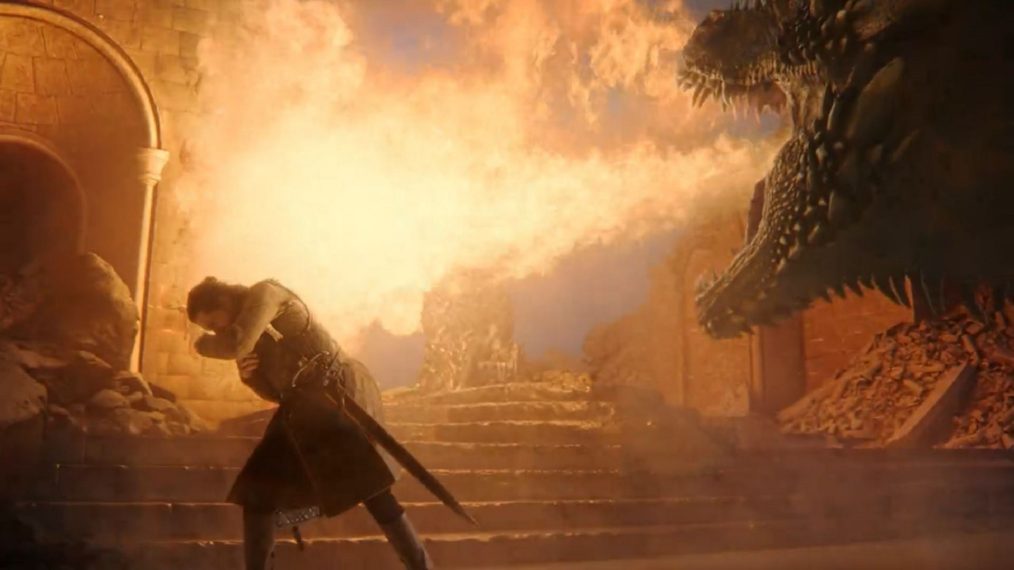Why Drogon Didn’t Kill Jon Snow in the ‘Game of Thrones’ Finale — and Where He Went

[Warning: The below contains MAJOR spoilers for the Series Finale of Game of Thrones, “The Iron Throne.”]
The Game of Thrones series finale left fans with a lot to think about, but one of its biggest unanswered questions involved the lone surviving dragon, Drogon.
If you’ve yet to tune in, stop reading now as the following is littered with fiery spoilers.
As fans anticipated heading into the final installment, the “new” Mad Queen Daenerys’ (Emilia Clarke) fate was sealed as she took power. In a scene between her and Jon Snow (Kit Harington), she’s swiftly extinguished of her life with a dagger to the chest. Obviously, her “child” Drogon could sense trouble, and he came bounding towards the Iron Throne as Jon cradled her lifeless body.
When Jon backs away and Drogon nudges Daenerys, only to learn that she’s in fact dead, he cries out and opens his throat as the orange light of flames grows brighter before erupting from his mouth. While some may have thought Jon would be a charred piece of toast for what he did, Drogon surprised us by turning his flames towards the Iron Throne.

(Credit: HBO)
Instead of taking out the man who killed his mother, Drogon melted the Iron Throne down into unrecognizable metal puddles before plucking Daenerys’ body up and flying away. So, why didn’t he burn Jon to death?
We have no way of knowing for sure — there are many different theories, but three remain the most likely. First, Jon is half Targaryen, and as a member of the family whose sigil consists of dragon imagery, his connection to Drogon likely goes beyond our visual abilities. The prime example proving this theory is Jon’s ability to ride Rhaegal this season — the dragons never let anyone near them, at least not near enough to ride like they had with Jon.
The next theory is that because Jon is Targaryen that he can’t burn — a valid point considering that Daenerys couldn’t burn either. Ultimately, we’ll likely never know if this is the case since it was never explored. (There was a moment in Season 1 where Jon burns himself on a lantern, but maybe that doesn’t apply to dragon fire?) But the third theory carries the most weight and makes the most sense symbolically.
As Drogon turned his attention to the Iron Throne, he aimed his anger at the thing that took his mother’s life — the seat of power. Sure, Jon may have physically killed Daenerys, but it was her pursuit of power that turned her into the Mad Queen and eventually led to her seemingly necessary demise.

(Credit: HBO)
Throughout the series Daenerys claimed that she wanted to break the wheel of power in Westeros, but by taking the Throne herself, she instead repeated the past. Drogon’s melting of the Iron Throne broke that wheel that Daenerys frequently spoke of while also sending a clear message that if Daenerys couldn’t have it, then no one should.
The burning of the Iron Throne stood as a message about how power can be damaging, and in order to correct that damage the system that’s currently in place must be destroyed and rebuilt. This was the case in the series finale which saw an unsuspected character take the lead by unusual means in Westeros standards. Bran the Broken (Isaac Hempstead Wright) became the King of the Six Kingdoms by a vote — an unprecedented move in a world where previous rulers had been made through family legacy and lineage.
And after that symbolic gesture, where exactly did Drogon set off to? Well, in the final moments of the episode as Bran asks his council about Drogon’s whereabouts, he’s told by Samwell (John Bradley) that the dragon was last spotted flying east, but where exactly is never elaborated. Perhaps Drogon returned to Essos, which was his place of birth? It would make sense if he were to bring Daenerys’ body, considering her ties to the land there.
No matter the outcome, it’s clear that Drogon is more insightful than some may have previously thought, and despite not being human, he spoke volumes with his actions.











